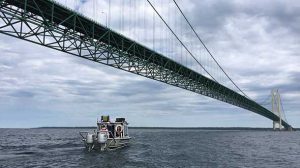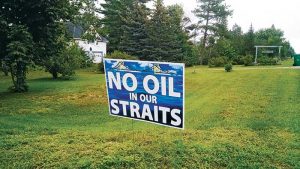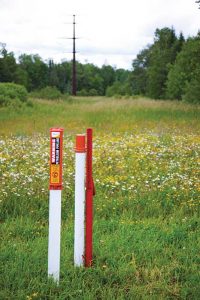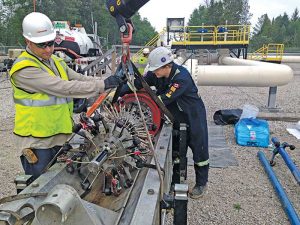Line 5 pipeline dispute in Michigan poses potential future supply issues

Enbridge performs an external inspection of the pipeline near the Mackinac Bridge. Photo Courtesy of EnBridge
Recent concern over the structural integrity of Enbridge Line 5 has caused Michigan lawmakers to begin considering alternatives to the 63-year-old pipeline that moves the crude oil and natural gas liquids (NGLs) from which the state and surrounding regions derive the majority of their propane.
Environmental groups, Michigan residents and state officials, including Attorney General Bill Schuette, are calling for the state to take the pipeline, which runs under the Straits of Mackinac, out of service.
However, if this were to happen, propane supply and prices in Michigan, the Midwest and the mid-Atlantic regions would be affected, propane industry leaders say.
The winter of 2013-14 was exceptionally cold in much of the country, and the propane industry faced regional supply and distribution issues. Decommissioning the pipeline, paired with another cold winter, could leave retailers throughout the Midwest scrambling to provide customers with the propane they need to heat their homes.
This year’s heating season would remain largely unaffected, as it is unlikely a decision about the pipeline will be reached before the end of 2017. Yet, within the next year, some changes may be in store for where Michigan sources its propane supply.
The National Propane Gas Association (NPGA) and the Michigan Propane Gas Association (MPGA) have emphasized that supply issues in a top propane-consuming state like Michigan could also result in supply issues throughout the surrounding regions.
According to Jeff Petrash, vice president and general counsel at NPGA, “Michigan regularly rates number one or number two in terms of propane consumption nationally. This is a big deal.”
Inadequate alternatives

Homeowners in northern Michigan protest the presence of Line 5 under the Straits of Mackinac. Photo by Paul Richter
The state selected Dynamic Risk Assessment Systems Inc., a third-party pipeline analysis company, to conduct a study assessing threats to the pipeline, detailing spill scenarios and suggesting alternatives to running the pipe under the Straits of Mackinac. The report does not offer suggestions as to which alternatives should be pursued.
Though the state oversaw the studies, Enbridge, the owner of the pipelines, paid $3.5 million for the study to be conducted, according to the State of Michigan Attorney General’s office.
At the end of June, Dynamic Risk released a draft copy of the Alternatives Analysis for the Straits Pipeline, which was made available for public comment.
Derek Dalling, executive director of MPGA, spoke about some of the proposed alternatives, their feasibility and the overall impact they might have on the industry.
■ Trucking: According to the report, transporting the same amount of oil via truck as is transported by the pipeline would require 3,200 trucks every 40 seconds. Not only is this logistically unfeasible, Dalling notes that there are not enough trucks or drivers to move the same amount of product.
■ Rail: The report states that it would take nine trains per day, each with 100 cars dedicated solely to transporting fuel, to transport an amount equivalent to the pipeline. Additionally, Dalling says there are not enough railcars to even make this alternative feasible.
■ New pipelines: New pipelines extending north, through Canada, or south, around the end of Lake Michigan, would be both expensive and difficult to build.
■ Replace with a trenched pipeline: This is just a new Line 5 through the Straits of Mackinac, according to Dalling.
■ Replace with a tunnel pipeline: The “belt and suspenders” approach, according to Petrash. This alternative would consist of building a new pipeline, but surrounding it with a concrete tunnel. It is probably the most feasible and least expensive, but Dalling notes that the tunnel would still have to go through water.
■ Banning crude throughput: There has also been discussion of banning the movement of crude oil through the pipeline while still allowing the throughput of NGLs. However, since NGLs only account for 15 percent of the total flow through Line 5, continuing to operate the pipeline without crude would be uneconomical, Dalling says.
The final alternative is shutting down the pipeline. This, however, would have significant impacts on propane retailers, as well as residents of Michigan and the Midwest who rely on propane.
Supply struggles
The state of Michigan is second only to California when it comes to propane sales, according to a 2015 report from the American Petroleum Institute.
More than 321,000 households in Michigan rely on propane for heat, NPGA says. About 301,000 of these households are in the Lower Peninsula, with more than 20,000 in the Upper Peninsula.

An Enbridge pipeline marker indicates the presence of the pipeline in Michigan’s Upper Peninsula. Photo Courtesy of Enbridge
Roughly 450 million gallons of the 600 million gallons of product that flow through Line 5 per year are refined into propane that is used in Michigan, Dalling says. The pipeline supplies the Upper Peninsula with 65 percent of its propane, and more than 50 percent of the propane used in the Lower Peninsula is produced from crude oil and NGLs carried by Line 5.
Action taken to stop or redirect the throughput of Line 5 would increase the cost of propane for Michigan residents, according to the Alternatives Analysis. The first three proposed alternatives (trucking, rail, new pipeline) could raise propane prices anywhere from 10 to 35 cents per gallon. If the pipeline were to be shut down, the cost of propane in the Upper Peninsula would increase in the range of 10 to 25 cents per gallon, the analysis notes.
Not only would consumers see price increases, the industry could also face supply issues. Without the pipeline, retailers that supply to homes in Michigan will have to go elsewhere to get their propane, which could have a significant impact on the market in Michigan and its surrounding states.
“Because Michigan is the biggest propane state, all the marketers in Michigan [would] have to go elsewhere, which sends a ripple effect from Maine to the Rocky Mountains. All of that area will be covered by propane marketers going further and further away,” Dalling says. “That’s a couple hundred marketers that have to go further away. It’s a domino effect on things.”
Michigan retailers would not be the only ones faced with going farther afield for supply. Though the majority of the propane produced from Line 5 crude oil and NGLs is used in Michigan, surrounding states such as Ohio, Pennsylvania and Illinois, as well as regions in Ontario, Canada, also rely on the propane produced in Sarnia, Ontario, and stored in underground caverns in Marysville, Michigan.
According to Petrash, propane produced from Line 5 crude oil and NGLs at Sarnia’s petrochemical complex ends up going as far east as Virginia.
MPGA notes that Michigan retailers going elsewhere for their product could displace retailers in other parts of the Midwest, which would force those retailers to look elsewhere for their propane supply.
“In other words, there would be ripple effects to the propane supply chain felt throughout the Upper Midwest region from a disruption in the Upper Peninsula alone,” MPGA says.
NPGA and MPGA are working to raise awareness of the issue and the potential impacts on surrounding areas. They are emphasizing that Michigan would not be the only state affected if the pipeline is shut down.
“We believe that this is not just a Michigan problem. It’s the entire region. It’s made more critical by the fact that the Cochin pipeline went out of service three years ago,” Petrash says. “And before that, one of the two Enterprise pipelines that brought propane to the Midwest and Northeast was reversed, as well. Line 5 has considerably greater significance in light of those infrastructure changes.”
Safety first

An Enbridge crew works on a piece of equipment during a 2016 inspection of the pipeline. Despite inspections, many claim the pipeline has sustained structural damage over the years. Photo Courtesy of EnBridge
Though the pipeline is necessary to propane retailers and customers, industry members also understand the importance of protecting the Straits of Mackinac and the surrounding environment.
“While Line 5 is a vital piece of infrastructure to the propane industry, the propane industry does not condone leaking pipelines of any kind anywhere in our state. The Michigan Propane Gas Association’s primary purpose is to promote the safe use of propane in our state and industry,” MPGA says.
Although pipeline transport is the safest way to move oil and NGLs, Petrash notes that NPGA still expects Enbridge to use every tool at its disposal to ensure that the pipeline is safe.
“In our members’ businesses, safety is always number one,” Petrash says. “If you don’t have a safe business, you don’t have a business. We expect Enbridge to operate in a safe manner.”
Critical omission
Individuals, as well as environmental groups, state agencies and industry leaders, were given until Aug. 4 to submit official comments and suggested revisions to the Alternatives Analysis. Both NPGA and MPGA weighed in.
One of the biggest omissions in the report is the failure to directly address the effect of closing Line 5 on propane supply and pricing in the Lower Peninsula.
“It appears the only folks talking about propane below the bridge are MPGA and NPGA,” Dalling says. “The storage downstate is what is used to heat the majority of Michigan and is where much of the region, including Ontario, gets its propane stored.”
NPGA and MPGA are both calling on Dynamic Risk to consider the Lower Peninsula when it makes revisions to its report. According to NPGA, the Lower Peninsula must be analyzed in order to achieve an accurate picture of the options for Line 5 and the effects of closure.
By not accounting for the Lower Peninsula, the report fails to address the scope of the issue. The Lower Peninsula has many homes that rely on propane, and more than half of that propane comes from product carried on Line 5.
In order for lawmakers to understand the full impact of shutting down Line 5, NPGA is asking Dynamic Risk to make these additional revisions to its analysis before submitting its final draft:
■ Consider the effect a pipeline shutdown would have on Upper Peninsula supply that does not originate from the Plains Midstream Rapid River facility in Rapid River, Michigan.
■ Expand the basis for the analysis to include the winter of 2013-14, since in those years the impact on supply would have been much greater.
■ Address the loss of propane supplies to regional propane markets. The report does not consider the loss of reliability between pipeline, rail and truck delivery and the extra cost consumers could incur.
















